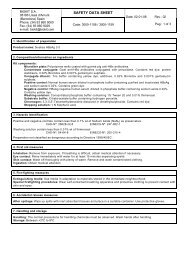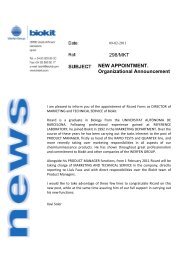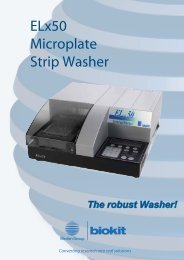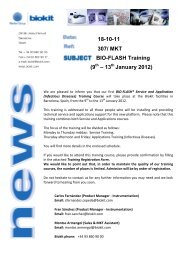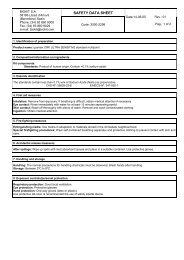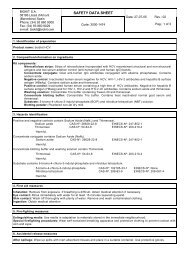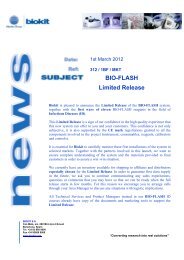Bioelisa HTLV I+II 5.0 Product improvement - Biokit
Bioelisa HTLV I+II 5.0 Product improvement - Biokit
Bioelisa HTLV I+II 5.0 Product improvement - Biokit
You also want an ePaper? Increase the reach of your titles
YUMPU automatically turns print PDFs into web optimized ePapers that Google loves.
ioelisa3. Crystals may form when Concentrate Washing solution (20x) is stored at 2-8°C. These must be dissolved bywarming at 37°C prior to use.4. The stability of the kit after first opening is 12 months. Kit expiry will be the earliest expiry date either in the Closedor Opened condition.5. Opened, unused microplate strips must be stored with the desiccant provided at 2-8°C in a closed pouch.Collection of samplesSerum or plasma samples collected in EDTA, heparin, sodium citrate, K-Oxalate, or acid citrate dextrose (ACD)may be used. Before storage, ensure that blood clot or blood cells have been separated by centrifugation.Fresh samples are preferred, specimens that undergo freezethaw cycles repeatedly are not recommended.Samples should be stored 2-8°C if the test is to be run within 7 days of collection or frozen at -20°C if the test is tobe delayed for more than 7 days. IN addition, up to 0.1% sodium azide may be used to stabilize serum or plasmasamples stored at 2-8°C.Clear, non-haemolysed samples are preferred. Lipemic, icteric or contaminated (particulate) samples should befiltered (0.45 µm) or centrifuged before testing.Specimens can be virus inactivated, although it might not be optimal for test performance as potential effect of thetreatment on IgM antibody is not fully undderstood. If necessary, inactivate as follows:1. Loosen caps of serum containers.2. Heat specimen at 56°C for 30 minutes in a water bath.3. Allow serum to cool down before re-tightening caps.4. Serum can be stored frozen until analysis.Repeated freeze-thawing of the sample is not recommended.Material required not provided1. Disposable absorbent bench top paper and paper towels.2. Polypropylene tubes or containers.3. Graduated pipettes: 5 ml, 10 ml.4. Multichannel pipette capable of delivering 50 µl, 100 µl and 200 µl.5. Pipettes capable of delivering 1 - 1000 µl.6. Disposable pipette tips.7. Reagent reservoirs (troughs) with a capacity of 25 ml.8. Deionised or distilled water, reagent grade quality.9. Flasks: 500 ml, 1 litre.10. ELISA microplate washer. Alternatively, washing can be performed manually by using a multichannel pipettedelivering 0.3 ml volumes and an aspirator device.11. A 37 ± 1°C incubator.12. Microplate reader with a 450 nm filter. Reference filter of 620 or 630 nm is advisable.13. Effective disinfectant.Automatic processingAutomated or semi-automated assay may be used with different instruments. It is very important to validate anyautomated system to demonstrate that results obtained for samples are equivalent to the ones obtained usingmanual assay. It is recommended that the user validate periodically the instrument. If there is any difficulty in thesetting of <strong>Biokit</strong> automatic processors, please contact your distributor.Preparation of reagents1. WORKING CONJUGATEa. WORKING CONJUGATE should be prepared fresh prior to use.b. Mix conjugate and diluent thoroughly before use. DO NOT SPIN the conjugate vial.c. Dilute conjugate at 1:200 dilution factor with diluent. For example, add 10 µl conjugate into 2.0 ml diluent.d. Use only polypropylene containers or tubes.BIOKIT, S.A. - 08186 Lliçà d’Amunt - Barcelona - SPAIN08433000-1165 R02 03.2010 eng.doc



